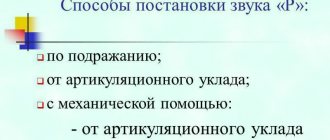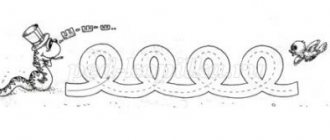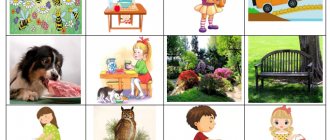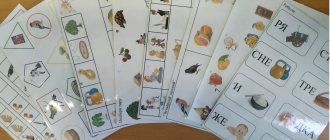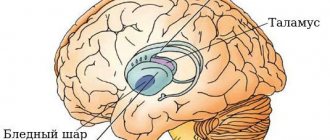Summary of an individual lesson on sound production [C]
Summary of an individual lesson on sound production [C]
Target:
production of the sound [S] by imitation.
Tasks:
Correctional and developmental:
— prepare the articulatory apparatus for producing the sound [C];
- give a description and correct articulation of the sound [C];
- put the sound [C] by imitation;
- teach to pronounce the sound [C] - words in isolation, in syllables;
- develop the correct air stream.
Correctional and developmental:
- develop the ability to understand spoken speech;
— develop mental processes: attention, memory, thinking;
- develop phonemic processes;
- develop general motor skills.
Educational:
- develop self-control.
Equipment: large wall mirror, a manual for creating an air stream, games “Collect beads”, “Echo”, a picture of a breeze
Progress of the lesson
1. Organizational moment
Speech therapist:
Hello Vika. Do you know what time of year it is?
Child:
spring.
Speech therapist:
Right.
the spring breeze
came to visit us (a picture is displayed). He wants to teach you to sing his song. Will you study?
Child:
Yes
2. Finger gymnastics
Speech therapist:
Let's remember the game about the breeze
“The wind flew through the forest”
The wind flew through the forest,
The wind counted the leaves. (smooth, wave-like movements of the palms).
Here's an oak one,
Here's a maple one,
Here is a carved rowan tree,
Here is a golden one from a birch tree (they bend one finger on both hands).
Here is the last leaf from the aspen tree
The wind threw it onto the path (calmly place their palms on the table).
3. Exercises to develop speech breathing
Speech therapist:
The breeze wants you to learn to blow as hard as it does.
Exercise to develop air pressure:
Having drawn air into your lungs, forcefully blow (and not just exhale) it through your lips extended forward like a “tube”. Control the exhaled stream with your palm, piece of paper or cotton wool: you feel a sharply beating cold stream of air, the paper or cotton wool is deflected to the side. Repeat the exercise 3-5-7 times.
The game may be called “Blow on a spring leaf!”
(various leaves cut out of cardboard are hung on a cocktail stick by a thread).
4. Articulation gymnastics
Speech therapist:
In order to learn to sing the song of the spring breeze, we need to stretch our tongue. The child, according to the instructions of the speech therapist, performs articulation gymnastics: exercises “Swing”, “Tube”, “Punish a naughty tongue”, “Let’s brush our teeth”.
5
.
Development of facial muscles
Speech therapist:
Vika, do you like spring? (Yes)
Speech therapist:
Smile, show me how you like her
Child:
shows joy, smiles
.
Speech therapist:
Do you get upset when it’s cold raining outside and the wind is blowing?
Child:
Yes
Speech therapist:
Show me how upset you are!
Child
shows sadness
Speech therapist:
Would you be surprised if it snows tomorrow?
Child:
Yes
Speech therapist
: Show me the surprise on your face!
Child:
shows
surprise
6. Staging sound by imitation.
The speech therapist invites the child to smile broadly in front of the mirror, show his teeth (make a “Fence”), and then, without unclenching his teeth (“Don’t break the fence!”), blow strongly, like:
— spring breeze – sssssssssssssssssssssssssssssssssssssssssss
- Pump - SSSSUSSSSSSSSSSSSSSS ........
The speech therapist draws the child’s attention to a “thin whistle” and a cold exhaled stream of air, which he can feel on the back of his hand.
Speech therapist:
Well done!
Speech therapist:
Where is the tip of the tongue when pronouncing the sound [C]?
Child:
behind the lower teeth.
Speech therapist:
Vika, repeat after me straight syllables with the sound [S]: sy-se-su-sa-so. And now the reverse: ys-as-os-us-es.
7. Development of phonemic processes
Speech therapist
: I will now pronounce sounds, and when you hear the sound [S], you should clap your hands:
a, k, z, s, w, p, s, etc.
8.
Fizkul
The wind quietly shakes the maple tree,
Tilts right, left:
One - tilt and two - tilt,
The maple leaves rustled.
(Feet shoulder-width apart, hands behind the head. Torso tilts to the right and left.)
9. Game "Echo"
Playing the game “Echo”, the speech therapist shows a picture and pronounces the words, and the child repeats after the speech therapist like an echo, Words: hay, sleigh, himself, snow, boots, sleep, Sonya, soup, bag, son.
10. Game to develop attention, memory, thinking, speech
“Collect beads”
Speech therapist:
Vika, look. The breeze is such a mischief. I had beads. They were on a thread. But the breeze blew and my beads scattered. Help me collect them.
(the beads consist of pictures, round in shape, with words depicted on them with the sound
[C])
11. Summary of the lesson
Speech therapist:
Who came to visit us?
Child:
spring breeze.
Speech therapist:
Vika, let's remember what the spring breeze taught us
Child's answer
Speech therapist:
How the pump whistles (how the breeze blows).
Speech therapist:
Repeat after me the forward and backward syllables.
Sound setting [c]
- Today in class we will learn to pronounce the sound [s].Organizes work with the profile.
-Look at the profile. (The profile is placed on the board, the teacher tells, accompanied by a show) When pronouncing the sound [c]. The lips are in a smile. The teeth are close together, but not closed. The tip of the tongue rests on the lower incisors. The back of the tongue is wide, spread out. The lateral edges of the tongue are raised up and pressed tightly against the upper molars. The vocal cords are resting. The throat does not tremble. There is no voice.
Organizes work with the mirror.
Listen to the water flowing. (I make the sound s-s-s-s-s). This is how the sound [c] is pronounced.
Clarifies the pronunciation of the sound [c] by imitation.
-Take the mirror. Say the sound [c].
-What position do your lips occupy when you pronounce this sound?
Organizes sound production.
-And now you and I will learn to pronounce the sound [c] correctly and beautifully.
Gives instructions.
-Smile widely. Place your wide tongue between your teeth; the tip of your tongue should rest on your lower teeth. Don't bite your tongue. Blow on the tip of your tongue to feel the cool sensation. Place your palm on your mouth and make sure the air you exhale is cold.
I place the probe on the tip of the tongue along its middle midline and lightly press it on the tongue, forming a “groove” (through which air will escape).
When you press the tongue with a probe, you hear a vague “lisping” whistle.
-Place your teeth closer together so that only the probe is placed between them, and the tongue remains behind the teeth. And keep blowing on the tip of your tongue.
I press the tongue with the probe to find the position in which the sound [c] will sound correctly.
When the sound [c] sounds most correct, I carefully remove the probe.
-Now let’s “whistle like a mosquito.” (I determine whether the child can put his tongue in the right place and independently pronounce the sound [c].
Organizes the game “Catch the Sound” to develop phonemic awareness.
-Our sound [s] is so fast and I suggest you play the game “Catch the Sound.”
-I will name the sounds, and you will catch the sound [s] among other sounds. When you hear this sound, clap.
- d, s, z, s, k, w, s, t, s.
-So you caught the sound [s]. Where did you catch the sound?
-You completed this task, but there are other tasks that are more difficult.
-I will pronounce the syllables, and you will catch the syllable that contains the sound [s].
- Sa, sha, zu, su, mu, so, she, you, sy.
-What did you catch the sound in just now?
-Well done! You are good at completing tasks. And I offer you one more task. We will catch the sound [c] among the words.
- We will catch the sound [s] in words.
- I will name the words, and you “catch” the words with the sound [s] when you hear them.:
— A helmet, a flower, cheese, rocks, a sword, a ship, paint.
-What did you catch the sound among?
Organizes a physical session.
Organizes work with pictures.
Hands out envelopes with pictures to children:
Apple, owl, elephant, tree, sun, ship, dog.
- Without naming the pictures, put aside the pictures with sound [s].
— What did you learn while completing the task?
Summary of the subgroup speech therapy lesson “Sound production /S/”
Summary of a subgroup speech therapy lesson
Topic: Sound Staging [s].
TARGET:
—
Preparing the articulatory apparatus for sound production [s].
Program content:
• Teach children to hold the tip of their tongue behind their lower teeth and perform articulation exercises for sound[c].
• Create a long-lasting air stream.
• Practice distinguishing words that sound similar.
• Learn to identify the sound [s] by ear in a series of sounds.
EQUIPMENT:
Laptop, presentation of the fairy tale “Mitten”. Subject pictures with the image - (bone, soup, cabbage, carrot).
Progress of the lesson:
1. Organizational moment.
Speech therapist.
Good morning! Today in class we will play a computer game, don’t you agree? Then listen to my assignments. Sit back and listen to a fairy tale. (A presentation with the fairy tale “Mitten” appears on the screen.) Do you recognize this fairy tale? What is it called?
The children answer.
2. Main part.
The old man dropped his mitten in the field (1st slide), it lies under the trees (exercise “Fence”). A mouse ran past. She knocked on the window (exercise “Window”), but no one answered her. The mouse tried to open the door (exercise “Gate”).
Door opened. The mouse was at first wary, then indignant, and then laughed.
Children, together with the mouse on the screen, perform appropriate psycho-gymnastics.
The mouse entered the mitten and began to live there. I began to put my mitten in order (exercises “Punish a naughty tongue”, “Pancake”), got tired and sat down to rest (exercise “Cup”).
2. A frog jumped past the mitten (slide 2). She saw it, stopped near the door (exercise “Needle”), and asked: “Who lives in a mitten?” (Children help pronounce phrases.)
The mouse called the frog to come to him, and they began to live together in a mitten.
Every morning they lit the stove (the children blew on the tip of their wide tongue) and
cooked porridge.
Z. A hare galloped past (3rd slide).
He stopped and asked: “Invite me into the mitten. I have a basket of vegetables with me.
Finger gymnastics
Now we will help salt the cabbage for the hare.
“We chop cabbage”
We chop and chop cabbage! (2 times) (children imitate chopping movements with an ax, moving their straight palms up and down)
We cut the cabbage, cut it! (2 times) (move the edge of your palm back and forth) We salt the cabbage, salt it! (2 times) (gather your fingers into a pinch and pretend to salt the cabbage)
We press the cabbage, press it! (2 times) (vigorously clench and unclench your fists)
We three carrots, three! (2 times) (squeeze the right hand into a fist and move it up and down along the straight palm of the left hand, pretending to be a grater).
Everything was compacted into the tub (
They rub fist against fist.)
Summary of individual speech therapy sessions. Automation of sound C
Summary of an individual speech therapy lesson on sound automation [C] in syllables, words and sentences
Author: Anastasia Igorevna Korogodina, teacher - speech therapist, Municipal preschool educational institution "Nursery - Garden No. 170 of the city of Donetsk" Description of work: this material will be useful for speech therapist teachers ; the material is intended for children 5 years old; This material is used in individual work on automating the sound “C” in syllables, words and sentences. Objectives: 1. Educational:
automation of the sound [S] in syllables, words and sentences.
2. Correctional:
• consolidate the skills of correct pronunciation of the sound [C] in syllables, words, sentences;
• develop articulatory and fine motor skills; • develop phonemic hearing; • develop speech breathing; • develop clarity of diction and intonation expressiveness. 3. Developmental:
• consolidate the ability to determine the place of a sound in a word;
• develop attention, memory, thinking; • practice the ability to complete a sentence grammatically correctly. 4. Educational:
• create positive motivation in the classroom;
• develop verbal communication skills and listening skills. Equipment: “Sonya the Dog” toy, “Su-Jok” massager, incentive sticker. Progress of the lesson 1. Organizational moment. Breathing exercises. Speech therapist: The bell gave us a signal: The hour has come to work. So we don’t waste time and start working. — inhale deeply through your nose, exhale through your mouth, inhale and exhale deeply again. 2. Articulation gymnastics. 1. “Smile” / “Tube” Holding your lips in a smile.
The teeth are not visible. Pulling closed lips forward. Once again. If our lips smile, Look - a fence appears.
Well, if the sponges are a narrow tube, then we can play the pipe. 2. “Clock” / “Pendulum” The mouth is slightly open.
The lips are stretched into a smile. With the tip of the narrow tongue, alternately reach to the corners of the mouth at the teacher’s count. One after another, one after another, the arrows go around in a circle.
You lick both lips, show how the arrows move. 3. “Punish the naughty tongue.” Smile widely.
Place your wide tongue on your lower lip and, lightly biting it with your teeth, say “ta-ta-ta” for 5-10 seconds. Then slap your tongue with your lips, saying “five-five-five” for 5-10 seconds. Your tongue is a mischief maker, It doesn’t listen to you.
Punish him quickly: “Five-five, five-five, five-five-five!” 4. “Pancake” The mouth is open, a wide, relaxed tongue lies on the lower lip.
We slap the tongue with our upper lip: five-five-five. We slightly bite our tongue: ta-ta-ta. In the morning we get up early and bake delicious pancakes.
The dough spreads like a stream across the frying pan... Look how beautiful the Pancake turns out. 5. “Brush your teeth” Smile, open your mouth with the tip of your tongue from the inside, “brush” the lower and upper teeth alternately.
Open your mouth, smile, show me your teeth, brush the upper and lower ones, because they are not superfluous.
6. “Gorka” Open your mouth.
Place the tip of your tongue against your lower teeth and lift the back of your tongue up. The tongue is lowered by the teeth, Its tip is pressed against the teeth.
The back arches very, very strongly - That's what a slide it turns out to be! 7. “Pussy is angry” Smile, open your mouth.
The tip of the tongue rests on the lower teeth from the inside (“mountain”). Roll out the wide tongue forward and move it deep into the mouth (slide). Repeat the exercise 8-10 times at a calm pace. Our pussy got angry: They forgot to wash her bowl.
Don't come close to her - her pussy might scratch her! 3. Finger gymnastics. Speech therapist: Look who came to us today! Who is this? This is a dog. What's the dog's name? Do not you know? I do not know either. Let's ask. Her name is Sonya. Let's introduce ourselves to Sonya, she's wondering who she'll be playing with today. Sonya loves to play with the ball. And now, we will show her how you can do it. Finger play with a “su-jok” massager.
I roll the ball in circles, I kick it back and forth.
I will stroke their palm. It’s as if I’m sweeping up a crumb, And I’ll squeeze it a little, Like a cat squeezes its paw, I’ll press the ball with each finger, And I’ll start with the other hand. Massage the fingers with an elastic ring “su-jok”.
One - two - three - four - five, /extend your fingers one at a time/ Let your fingers go out for a walk, This finger is the strongest, thickest and largest.
This finger is for showing it. This finger is the longest and stands in the middle. This ring finger is the most spoiled one. And the little finger, although small, is very dexterous and daring. 4. Articulatory image of sound. Speech therapist: Let's remember what position our lips, teeth and tongue occupy when pronouncing the sound “C”. The lips are stretched into a smile. The teeth are brought together and create a barrier to the air stream. The tip of the tongue rests on the lower teeth. 5. Pronunciation of an isolated sound [C]. Speech therapist: The dog Sonya really loves it when a cool breeze blows. Blow like a breeze S-S-S. 6. Physical education minute. We will blow high: S-S-S (The child stands on his tiptoes, raises his arms up) We will blow low: S-S-S (The child squats) We will blow far: S-S-S (The child straightens up, leans forward, arms outstretched ) We will blow close: S-S-S (Standing straight, hands raised to mouth) 7. Development of phonemic hearing. Speech therapist: Clap when you hear the sound “C”. P M S S A U K D S T S B SA MA SO BO SY AS YOU SU GI JUK SOUP SON HOUSE GARDEN SAM NOSE 8. Automation of sound (C) in pure language. Speech therapist: Imagine, our Sonya was bitten by a wasp. Now she is not friends with her. And you and I must reconcile them. We will repeat all the syllables, we will win this quarrel. SA-SA-SA, SA-SA-SA - a wasp bit me on the nose. SO-SO-SO, SO-SO-SO - my nose became like a wheel. SU-SU-SU, SU-SU-SU - I carry a wasp in my hand. SY-SY-SY, SY-SY-SY - I'm not afraid of the evil wasp. 9. Automation of sound (C) in words and sentences. Speech therapist: And now we will play the game “Sound Closet”. Name all the words. Make sure you pronounce the sound correctly.
Speech therapist: Look at the picture and say what the dog Sonya saw. Answer in a complete sentence. The dog Sonya saw...
10. Summary of the lesson. Speech therapist: What did you like most? Who did you play with today? What is the dog's name? 11. Assessment of the child’s speech activity. Speech therapist: You did great today, you pronounced the sound [S] correctly. Speech therapist: And Sonya also liked the way you played with her and performed various tasks. For this she wants to thank you and give you this sticker as a souvenir. Well done! References. 1. Yavorskaya O. N. Entertaining tasks of a speech therapist for preschoolers. – St. Petersburg: KARO, 2015. 2. Agranovich Z. E. Collection of homework for overcoming the underdevelopment of the phonemic aspect of speech in older preschoolers. To help speech therapists and parents. - St. Petersburg, 2007. 3. Zhukova N. S. Speech therapist lessons: correction of speech disorders. – M.: Eksmo, 2013. 4. Iskhanova S.V. Game therapy in speech therapy: articulatory transformations. – Rostov n/a: Phoenix, 2013.
We recommend watching:
Summary of an individual lesson on differentiating the sounds S and T for children 5-6 years old Summary of subgroup correctional activities of a speech therapist teacher with children of the senior group with FFND Summary of a speech therapy lesson in the middle group of a kindergarten: Sound and the letter P Structure of a speech therapy lesson on sound automation. Correction of sound pronunciation.
Similar articles:
Musical lesson using logorhythmics in the senior group of a preschool educational institution
